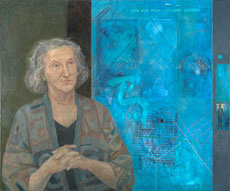On 13 May, Musgrave’s Remembering Harriet premieres at the Brooklyn Philharmonic led by Chelsea Tipton II. “The heroic African-American, Harriet Tubman,” Musgrave shares, “escaped from bondage on the Eastern Shore of Maryland to become the famous conductor ‘Moses’ on the Underground Railroad, rescuing over 300 of her people. Her story is compelling and human. About 20 years ago, Evans Mirageas [Brooklyn’s artistic advisor] saw the opera and was deeply moved by it, so much so, that many years later, he asked me to write a concert work based on the opera for the Brooklyn Philharmonic. I kept the key scenes and added a narrator in order to keep the story line flowing. What Harriet did is amazing, and is a testament to what one individual facing insuperable difficulties is capable of accomplishing.”

Portrait of Thea Musgrave by Victoria Crowe, which was commissioned and entered in the National Gallery of Scotland earlier this year. Credit: Antonia ReeveOn the 19th, mezzo-soprano Tracie Luck and the Wheeling Symphony present the first performance of Danielpour’s Triptych from Margaret Garner, conducted by André Raphel Smith. Danielpour designed the three-movement work to “feature Margaret Garner’s understanding of love. These are Margaret’s three feature arias in the opera, but each one shows her character’s love in different ways. The first aria is a mother’s love for her children. The second is an understanding of herself as a person to be loved. The final movement, or Intermezzo, shows Margaret speak about love to God (or the Cosmos) in terms of a sense of self dignity and self worth.”
Thea Musgrave
Remembering Harriet
Duration: 55'
Soprano, Contralto, Baritone; Narrator; SATB
22(ca).22(cbn)/3330/timp.2perc/hp.pf/str
Richard Danielpour
Triptych
Duration: 15'
“Margaret’s Lullaby”
“A Quality Love”
“Intermezzo and Soliloquy”
Mezzo-soprano; 322+bcl.3+cbn/4231/timp.3perc/hp.pf/str





